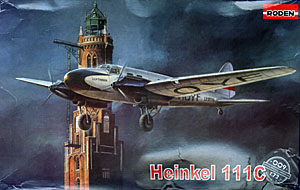Roden's 1/72 Heinkel He111C | | History Most of us know of the Heinkel He111 from the Battle of Britain, both the actual conflict and the movie from the 1960s. But the He111 saw combat long before England, with the first versions fighting in the skies over Spain. These early Heinkels differed from the later Battle of Britain ones in that they had a more traditional cockpit section and different engines. Even more interesting, however, was the airliner version of this famous bomber. The Heinkel He111C used the same BMW engines as the He111A, but instead of bombs and guns it carried 10 passengers in a comfortable cabin. A total of six He111Cs were produced, all flying for Lufthansa. A couple even flew as courier aircraft in the south Atlantic. The He111C quickly proved itself to be uneconomical as an airliner and the He111Cs were quickly moved into more covert jobs, such as reconnaissance missions over France, England and the Soviet Union. After the war started, the He111Cswere used as liaison aircraft. 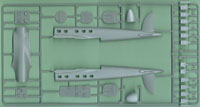 The Kit The Kit Toko's 1/72 kits of the early Heinkel 111s have been long-awaited, and when Toko was absorbed by Roden I was happy to learn that these kits would still be released. Now I have one in my hands and I am only 1/4 happy. I need to buy three more to be fully happy. Initially I was torn as to which early Heinkel I wanted to start first, but when I saw the airliner bird I was hooked. With only six of these planes in existance, I figured my research would be down to a minimum compared to my other Heinkel projects (Spanish Civil War He111B, Chinese He111A, and pre-war 61/62/63 Luftwaffe He111B). 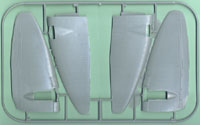 Upon opening up the box I was greeted with a bunch of parts injected in a medium gray plastic, with one tree of clear parts. All are pretty well molded, although this is definitely not a weekend slammer like a Hasegawa or Tamiya kit. The detailing on the surface is slight and will likely disappear on sanding, but the detailing on the interior, such as the wheel wells or cockpit sidewalls, is very well done and will look outstanding once painted up. Upon opening up the box I was greeted with a bunch of parts injected in a medium gray plastic, with one tree of clear parts. All are pretty well molded, although this is definitely not a weekend slammer like a Hasegawa or Tamiya kit. The detailing on the surface is slight and will likely disappear on sanding, but the detailing on the interior, such as the wheel wells or cockpit sidewalls, is very well done and will look outstanding once painted up.
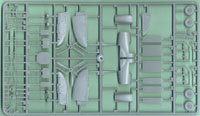 Speaking of the interior, this kit comes with a full cockpit and a full cabin, including a toilet and sink that is impossible to see once the fuselage halves are together. If you want to keep all of the cabin seats & interior details for something else, you can hide all of that by simply creating the curtains that were present in this plane, and sliding them closed over all the windows. While I'm still thinking about it, there is one very large and glaring omission in this kit, and that is the passenger entry door in the fuselage. There's no hint of a line where this door is and it took me a couple trips to the reference shelf to figure out where the door is supposed to be (right side, just behind the wing trailing edge). Speaking of the interior, this kit comes with a full cockpit and a full cabin, including a toilet and sink that is impossible to see once the fuselage halves are together. If you want to keep all of the cabin seats & interior details for something else, you can hide all of that by simply creating the curtains that were present in this plane, and sliding them closed over all the windows. While I'm still thinking about it, there is one very large and glaring omission in this kit, and that is the passenger entry door in the fuselage. There's no hint of a line where this door is and it took me a couple trips to the reference shelf to figure out where the door is supposed to be (right side, just behind the wing trailing edge).
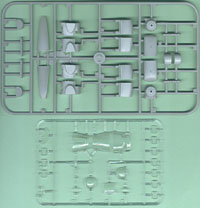 With so many small changes on the early Heinkels (mostly with engines), this kit is broken down to provide as many different options as possible, and this means that you'll be doing a lot of piecing things together. The fuselage is split into right and left halves, with a separate cockpit section and a separate nose. The BMW engines are made up of 10 different pieces each side, making for a very complicated assembly. The finished engine does capture the look of the BMW nacelle, though, so a bit of time here will pay off. With so many small changes on the early Heinkels (mostly with engines), this kit is broken down to provide as many different options as possible, and this means that you'll be doing a lot of piecing things together. The fuselage is split into right and left halves, with a separate cockpit section and a separate nose. The BMW engines are made up of 10 different pieces each side, making for a very complicated assembly. The finished engine does capture the look of the BMW nacelle, though, so a bit of time here will pay off.
The landing gear wells, as I've mentioned, are very well detailed, and the landing gear is equally well done. The landing gear on the Heinkel 111s is a rather unique shape and Roden does a good job of capturing that look without appearing too clunky. The wings will need a bit of extra work done to them, as there are some radiator housings molded onto them for the He111B model that need to be removed for the He111C (and He111A, but to do that plane you'll need the He111B fuselage with the BMW engines from the He111C).  The rest of the construction is very straightforward, and the only final challenge you'll have is in getting a nice, smooth finish to the model so you can apply the silver and black paint scheme. This is probably one of the more colorful Heinkels out there, finished in overall natural metal with black engine cowlings and a black nose. The red tailband with white circle and black swastika add a bit of color as well. The kit provides decals for only one He111C, this one being D-AQYF, the He111C-02 named "Leipzig". The decals are well printed and as the majority of the markings are just black codes and words, there is no registration to worry about. The rest of the construction is very straightforward, and the only final challenge you'll have is in getting a nice, smooth finish to the model so you can apply the silver and black paint scheme. This is probably one of the more colorful Heinkels out there, finished in overall natural metal with black engine cowlings and a black nose. The red tailband with white circle and black swastika add a bit of color as well. The kit provides decals for only one He111C, this one being D-AQYF, the He111C-02 named "Leipzig". The decals are well printed and as the majority of the markings are just black codes and words, there is no registration to worry about.
Conclusion This is a very welcome kit to any 1/72 collection, whether you build airliners, or Luftwaffe, or bomber twins. While it is not a kit for beginners and you'll have a fair amount of work cut out to get a nice metal finish, it is very buildable and will look stunning once completed. Our thanks to VAMP for the review sample. | 


 




    |
